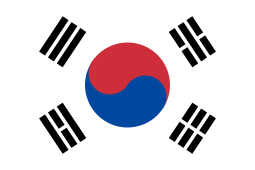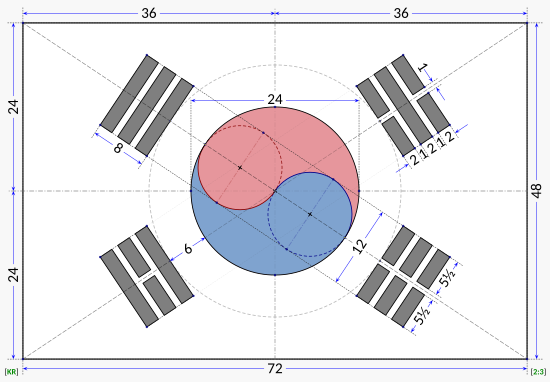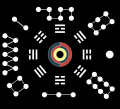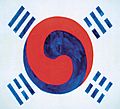Flag of South Korea facts for kids
 |
|
| Name | Taegeukgi / Taegukgi (Korean: 태극기, Hanja: 太極旗) |
|---|---|
| Use | National flag and ensign |
| Proportion | 2:3 |
| Adopted | January 27, 1883 (original version, used by the Joseon dynasty) June 29, 1942 (Provisional Government of the Republic of Korea) October 15, 1949 (as the flag of South Korea) May 30, 2011 (current version) |
| Design | A white field with a centered red and blue taegeuk surrounded by four trigrams |
| Designed by | Lee Eung-jun (Designed) Park Yung-hyo (Selected) Gojong (Approved) |

Variant flag of the Republic of Korea
|
|
| Use | Naval jack |
| Design | A Blue Ensign with a white canton that has a red and blue taegeuk superimposed in the center of the canton, with two anchors crossing. |
| Flag of South Korea | |
| Hangul |
태극기
|
|---|---|
| Hanja | |
| Revised Romanization | Taegeukgi |
| McCune–Reischauer | T'aegŭkki |
The national flag of South Korea is called the Taegeukgi (pronounced Tae-gook-gee). It is also sometimes spelled Taegukgi. This flag has three main parts: a white background, a red and blue circle in the middle, and four black symbols in each corner.
Flags similar to the Taegeukgi have been used in Korea for a long time. They were used by the Joseon dynasty, the Korean Empire, and even by the Korean government that was in exile during Japanese rule. South Korea officially adopted the Taegeukgi as its national flag on 15 August 1945, when it became independent from Japan.
Contents
What the Flag Means: Symbolism of the Taegeukgi
The South Korean flag is full of special meanings. Each part of the flag represents important ideas about peace, balance, and harmony.
The White Background: Purity and Peace
The flag's background is white. This color is very important in Korean culture. In the 1800s, many Koreans wore white clothes every day. Even today, you can see white in traditional Korean outfits like the hanbok. The white color on the flag stands for peace and purity.
The Taegeuk Circle: Balance in the World
The circle in the middle of the flag is called the Taegeuk. This symbol shows how everything in the world is balanced. The blue part of the circle represents the sky. The red part represents the land. Together, they show how the sky and land work together in harmony.
The Trigrams: Movement and Harmony
Around the Taegeuk circle, there are four black symbols called trigrams. These trigrams (pronounced gwae in Korean) represent movement and harmony. Each trigram stands for one of the four classical elements and has its own special meaning:
| Trigram | Korean name | Celestial body | Season | Cardinal direction | Virtue | Family | Natural element | Meaning |
|---|---|---|---|---|---|---|---|---|
| geon (건 / 乾) |
heaven (천 / 天) |
spring (춘 / 春) |
east (동 / 東) |
humanity (인 / 仁) |
father (부 / 父) |
heaven (천 / 天) |
justice (정의 / 正義) |
|
| gon (곤 / 坤) |
earth (지 / 地) |
summer (하 / 夏) |
west (서 / 西) |
courtesy (례 / 禮) |
mother (모 / 母) |
earth (토 / 土) |
vitality (생명력 / 生命力) |
|
| gam (감 / 坎) |
moon (월 / 月) |
winter (동 / 冬) |
north (북 / 北) |
intelligence (지 / 智) |
son (자 / 子) |
water (수 / 水) |
wisdom (지혜 / 智慧) |
|
| ri (리 / 離) |
sun (일 / 日) |
autumn (추 / 秋) |
south (남 / 南) |
righteousness (의 / 義) |
daughter (녀 / 女) |
fire (화 / 火) |
fruition (결실 / 結實) |
The Story of the Taegeukgi: How the Flag Was Created
The Taegeukgi has a long and interesting history. It became the official flag after many years of discussions and changes.
Early Days: The Need for a National Flag
In 1876, Korea, then ruled by the Joseon dynasty, did not have a national flag. The king had his own special flag, but there was no flag for the whole country. This became a problem during talks with Japan. Japan had its flag, but Korea had nothing to show its country.
Some people suggested creating a national flag, but the government didn't think it was important at first. By 1880, Korea was talking more with other countries. This made having a national flag much more important.
Designing the Flag: Ideas and Changes
A Chinese official named Huang Zunxian suggested that Korea use a flag similar to China's. Korean officials discussed this idea with Chinese diplomat Li Hongzhang. Li agreed that Korea should have its own flag, but with some changes.
Later, during talks with the United States in 1882, the US representative Robert Wilson Shufeldt also suggested Korea adopt a national flag. This was to show Korea's independence. King Kojong then ordered officials to start working on a new flag.
Lee Eung-jun created the first design. Another official, Kim Hong-jip, suggested changing the colors to red, blue, and white. On 14 May 1882, before a treaty with the US, Park Yeong-hyo showed a small model of Lee Eung-jun's flag to the government. King Gojong approved it. Park Yeong-hyo was the first person to use this new flag in 1882.
On 27 January 1883, the Joseon government officially announced that the Taegeukgi would be the national flag.
The Flag Through History: From Exile to Today
In 1919, during a time when Korea was under Japanese rule, a flag similar to the current South Korean flag was used by the Korean government-in-exile in China. The Taegeukgi became a strong symbol of independence during this period.
After Korea became independent in 1945, the Taegeukgi continued to be used in the southern part of Korea. When South Korea was officially formed in August 1948, the current flag was declared official on 15 October 1949.
In 1984, the exact size and shape of the flag were officially set. Then, in 1997, the precise colors of the flag were also officially decided by the government. The current version of the flag was adopted in 2011.
The Taegeukgi in South Korean Society
The Taegeukgi is a very important symbol for the people of South Korea. It represents their history, culture, and national identity. Many South Koreans feel a strong connection to their flag. It reminds them of their shared heritage and their country's journey.
The flag is so important that a 2004 film about the Korean War was named Tae Guk Gi. This shows how deeply the flag is connected to the country's story.
How the Flag is Made: Specifications
The South Korean flag has specific rules for its size and colors to make sure it always looks the same.
Flag Dimensions: Size and Shape
The flag's width is three units for every two units of its height. This means it's a 3:2 ratio. The flag has five main parts: the Taegeuk circle and the four groups of bars (trigrams). The circle in the middle has a diameter that is half of the flag's height. The top part of the Taegeuk circle must be red, and the bottom part must be blue. The four groups of bars are placed in each of the flag's corners.
Flag Colors: Official Shades
The exact colors of the Taegeukgi are officially defined by law. Before 1997, the colors were not strictly set. In October 1997, the South Korean government decided to make the colors standard. This was made official by a presidential order.
The colors are defined using special color systems like Munsell and CIE. Here are the official colors:
| Scheme | Munsell | CIE (x, y, Y) | Pantone | Hex triplet (converted from CIE) |
|---|---|---|---|---|
| White | N 9.5 | N/A | N/A | #FFFFFF |
| Red | 6.0R 4.5/14 | 0.5640, 0.3194, 15.3 | 186 Coated | #CD2E3A |
| Blue | 5.0PB 3.0/12 | 0.1556, 0.1354, 6.5 | 294 Coated | #0047A0 |
| Black | N 0.5 | N/A | N/A | #000000 |
Images for kids
-
 Ensign of the Joseon dynasty navy
Ensign of the Joseon dynasty navy -
 Royal standard of the Joseon dynasty (1882–1907)
Royal standard of the Joseon dynasty (1882–1907) -
 Royal standard of the Joseon dynasty (1882–1907)
Royal standard of the Joseon dynasty (1882–1907) -
 Taegukgi by Park Yeong-hyo (September 1882)
Taegukgi by Park Yeong-hyo (September 1882) -
 Taegukgi (March 1883). "The flag of Goryeo belonging to the Great Qing" is written in Chinese characters. Joseon was often called 'Goryeo' in China.
Taegukgi (March 1883). "The flag of Goryeo belonging to the Great Qing" is written in Chinese characters. Joseon was often called 'Goryeo' in China. -
 The flag of the Korean Empire (1897–1910)
The flag of the Korean Empire (1897–1910) -
 Imperial standard of the Korean Empire (1897–1910)
Imperial standard of the Korean Empire (1897–1910) -
 Flag of the Provisional Government of the Republic of Korea from 1919 to 1948 used in exile in China
Flag of the Provisional Government of the Republic of Korea from 1919 to 1948 used in exile in China -
 The flag of the United States used during the U.S. military occupation of the southern part of Korea from 1945–1948
The flag of the United States used during the U.S. military occupation of the southern part of Korea from 1945–1948 -
The Unification Flag of North and South Korea
-
A large display of the South Korean flag during an association football match against Haiti
-
A series of South Korean flags flying on street
See also
 In Spanish: Bandera de Corea del Sur para niños
In Spanish: Bandera de Corea del Sur para niños


































